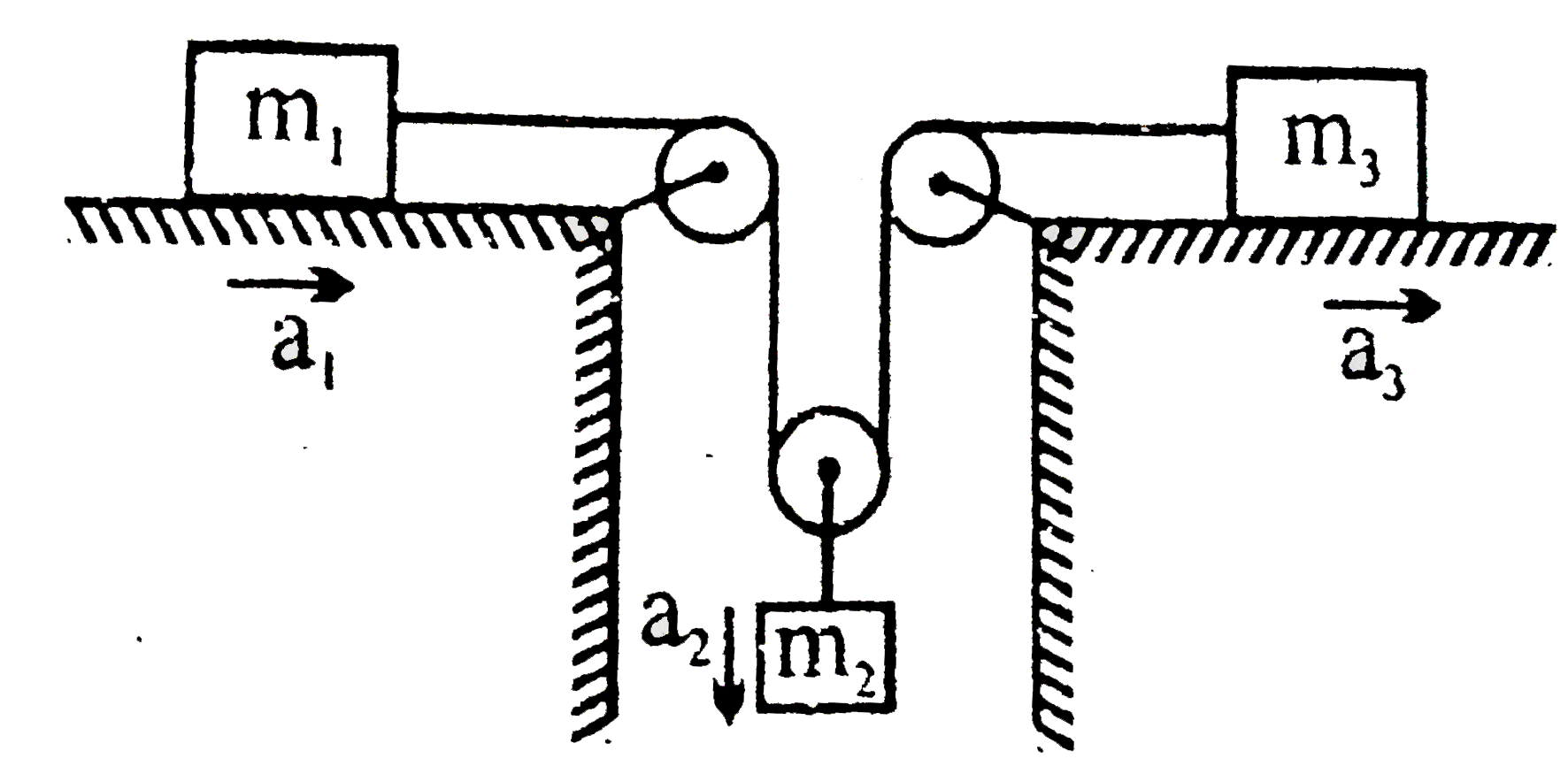Consider the system of masses and pulleys shown in fig. with massless string and fricitionless pulleys.
(a) Give the necessary relation between masses m1 and m2 such that system is in equilibrium and does not move.
(b) If m1=6kg and m2=8kg, calculate the magnitude and direction of the acceleration of m1.

(a) Applying newton's law m2g−2T=0 (because there is no acceleration) and T−m91)g=0⇒(m2−2m1)g=0⇒m2=2m1
(b) If the upwards acceleration of m1 is a, then acceleration of m2 is a/2 downwards For mass m2:m2g−2T=m2(a2)⇒2m2g−4T=m2a
For mass m1:T−m1g=m1a⇒a=2m2−4m1m2+4m1g=2(8−12)8+24g=−g4
Negative sign shows that acceleration is oppposite to considered direction i.e. it is downwards for m1 and upwards for m2.
Topper's Solved these Questions
- NEWTONS LAWS OF MOTIONBook:ALLENChapter:NEWTONS LAWS OF MOTIONExercise:SWOE
Explore 44 Videos
- NEWTONS LAWS OF MOTIONBook:ALLENChapter:NEWTONS LAWS OF MOTIONExercise:EXERCISE-I
Explore 52 Videos
- NEWTON'S LAWS OF MOTION & FRICTIONBook:ALLENChapter:NEWTON'S LAWS OF MOTION & FRICTIONExercise:EXERCISE (JA)
Explore 4 Videos
- RACEBook:ALLENChapter:RACEExercise:Basic Maths (Wave Motion & Dopplers Effect) (Stationary waves & doppler effect, beats)
Explore 25 Videos
Similar Questions
Two masses m1 and m2 are attached with light strings as shown. If the system is in equilibrium, find the value of θ

View SolutionIn figure shown, pulleys are ideal m1>2m2. Initially the system is in equilibrium and string connecting m2 to rigid support below is cut. Find the initial acceleration of m2 ?

View Solution
Knowledge Check
In the pulley system shown here, find the relationship between acceleration of m1,m2 and m3
 A2a1+a3+a1=0B2a2−a3+a1=0C2a2+a3−a1=0D2a2−a3−a1=0
A2a1+a3+a1=0B2a2−a3+a1=0C2a2+a3−a1=0D2a2−a3−a1=0Two masses m1 and m2 are attached to a string which passes over a frictionless smooth pulley. When m1=10kg,m2=6kg, the acceleration of masses is
 A20m/s2B5m/s2C2.5m/s2D10m/s2
A20m/s2B5m/s2C2.5m/s2D10m/s2In the system shown in figure mB=4kg , and mA=2kg . The pulleys are massless and friction is absent everywhere. The acceleration of block A is.
 A10/3m/s2B20/3m/s2C2m/s2D4m/s2
A10/3m/s2B20/3m/s2C2m/s2D4m/s2
In an atwood machine the two blocks have massess 1kg and 3kg. The pulley is massless and frictionless and string is light. The acceleration of the centre of mass (in m/s2) of this system is 0.5x. Find the value of x.
View SolutionConsider a system of masses M1 and M2(M1>M2) connected by a massless string in fig the system is pulled by a force F from the side of mass M1 and in fig
(b) the system is pulled by the same force F from the side of mass M2 then:

View SolutionTwo masses m1=5kg and m2=4.8kg tied to a string are hanging over a light frictionless pulley. What is the acceleration of the masses when left free to move?

View SolutionTwo blocks of masses M and m are connected with massless and frictionless pulleys as shown. Strings are also massless. If the magnitude of acceleration of M is a0 then magnitude of acceleration of m is

View Solution
For the following system shown assume that pulley is frictionless, string is massless (m remains on M),
Q. The acceleration of the block A is
View Solution